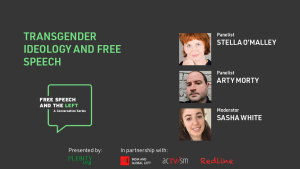The response from trans “advocates” to an Arkansas bill shows they do not actually care about reducing suicide among youth
I’ve had multiple kids in our emergency room because of an attempted suicide. Just in the last week… Multiple. So I guarantee you if this bill passes, children will die.”
― Dr. Michele Hutchison
Suicide is a national public health crisis. It’s also preventable, and there are things we know from decades of public research that can either increase the risk of suicide or decrease it. In the wake of a series of new bills in Arkansas meant to address the gender identity crisis in sports, medicine, and schools, trans “advocates” are foreshadowing an impending epidemic of suicide among trans-identifying youth. In doing so, they are flying in the face of all known research on preventing suicide, and quite possibly creating the very problem they claim they’ve set out to solve.
For those who have followed my activism and work in recent years, mostly focused on feminism and animal rights, my background in mental health advocacy may come as a surprise. In fact, I got my start as an activist and my first nonprofit experience in college working with Active Minds, a mental health advocacy organization that focuses on college campuses. I served as the co-president of my campus chapter where we organized events to reduce the stigma of mental illness, educated students about available resources, and encouraged them to seek help.
I never expected that only a couple years after graduating with my degree in psychology, but planning to pursue a different career direction, suicide would soon enter my life in a big way.
In 2015, when I was 22, my mom committed suicide. The reasons for this, as with any suicide, were complicated. She had been a victim of sexual abuse that haunted her still decades later. She had fallen into an abusive relationship. She had chronic illness and desperately needed health care she couldn’t afford without her husband’s insurance. She struggled to financially support herself and saw no way out of a desperate situation.
She’s not my only family member to have struggled with suicide. At many points, I have felt suicidal myself and for many years when I was younger I engaged in self-harm. Since my mom’s death, suicide has been the constant backdrop to my family dynamics. Risk of suicide increases among the family and friends of those left behind from suicide. There may be a genetic factor to this, but there is another factor, too. Suicide is deeply social.
The CDC describes this as a suicide “contagion.” It’s especially common among youth, people ages 15 – 24.
Decades of public health guidance has provided the media and advocates with the tools they need to ethically and responsibly report on suicide without contributing to contagion. In 1994, the CDC published guidance with recommendations for “health professionals, suicidologists, public officials, and others who provide information for reporting of suicide.” Some of that guidance includes:
“Suicide is never the result of a single factor or event, but rather results from a complex interaction of many factors and usually involves a history of psychosocial problems. Public officials and the media should carefully explain that the final precipitating event was not the only cause of a given suicide. Most persons who have committed suicide have had a history of problems that may not have been acknowledged during the acute aftermath of the suicide. Cataloguing the problems that could have played a causative role in a suicide is not necessary, but acknowledgment of these problems is recommended.” (emphasis added)
“Repetitive and ongoing coverage, or prominent coverage, of a suicide tends to promote and maintain a preoccupation with suicide among at-risk persons, especially among persons 15-24 years of age. This preoccupation appears to be associated with suicide contagion. Information presented to the media should include the association between such coverage and the potential for suicide contagion. Public officials and media representatives should discuss alternative approaches for coverage of newsworthy suicide stories.”
“Suicide is usually a rare act of a troubled or depressed person. [Presentation] of suicide as a means of coping with personal problems (e.g., the break-up of a relationship or retaliation against parental discipline) may suggest suicide as a potential coping mechanism to at-risk persons. Although such factors often seem to trigger a suicidal act, other psychopathological problems are almost always involved. If suicide is presented as an effective means for accomplishing specific ends, it may be perceived by a potentially suicidal person as an attractive solution.”
Those guidelines have barely changed in the nearly 30 years since they came out. This is basic, 101 level, public knowledge for anyone who wants it.
More recently, the website ReportingOnSuicide.org has also outlined in simple terms the Dos and Don’ts of covering suicide in the media. These points are summarized in the WoLF Media Style Guide for Reporting on Sex and Gender:
- Don’t present suicide as a common or acceptable response to hardship.
- Don’t oversimplify or speculate on the reasons for suicide – Don’t overstate the problem of suicide by using descriptors like “epidemic” or “skyrocketing”
- Report that coping skills, support, and treatment work for most people who have thought about suicide
- Provide context and facts to counter perceptions that the suicide was tied to heroism, honor, or loyalty to an individual or group
- Include Resources; at a minimum, include the National Suicide Prevention Lifeline, and Crisis Text Line, or local crisis phone numbers
- Emphasize Help and Hope
Overall, suicide completion is rare among children, including teenagers, compared to other age groups. However, there is evidence that trans-identified youth may be at increased risk of suicide. Research by The Trevor Project found that trans-identified youth had a higher rates of suicidal ideation and attempts than their gay, lesbian, and bisexual peers who did not identify as transgender. This isn’t a huge surprise, since gender dysphoria tends to also have high comorbidity with other mental illnesses which increase risk of suicide on their own, such as anxiety, depression, and autism, which is especially common among trans-identifying females and also linked with higher rates of suicidality. Girls aged 14-18, regardless of gender identity, tend to be especially prone to suicidal ideation compared to their male peers.
With all of this information readily available to advocates, you may think that those who claim to want to reduce suicide among a high-risk group would do everything in their power to limit the changes of a suicide contagion occurring. You would be wrong.
Groups that claim to advocate for the interests of trans youth, including the liberal media have opted to ignore nearly all guidance on reducing the risk of suicide contagion, and instead are waging a war of disinformation while using a vulnerable population as mere props for rhetorical debate.
In a hearing for Arkansas HB 1570, which would prevent doctors from performing experimental and dangerous gender medicine on minors, Pediatric Doctor Michele Hutchison stated to the committee, “I’ve had multiple kids in our emergency room because of an attempted suicide. Just in the last week… Multiple. So I guarantee you if this bill passes, children will die. And I will call you guys every single time one does.”
This threat was shared widely by the media, repeated without question by multiple outlets, none of whom followed best practices by including messages of hope, resources for those struggling, or a nuanced explanation of why people attempt suicide.
The CDC advises against rhetoric claiming that suicide is unpreventable or based on a single cause
The ACLU also shared this statement, and repeatedly made posts on social media claiming that “trans lives” were at risk.
This is only the latest in a wave of such claims. As the WoLF Media Style Guide points out, mainstream media outlets like Reuters and The Hill have been negligent in their reporting on trans suicide risk for years with headlines such as, “Vote for gender affirmation: Life and death choice.”
To be clear, whenever trans activists talk about “lives” being at risk, they are talking about suicide. There is no other reason having gender dysphoria or identifying as transgender would be a death sentence. If you only read liberal media or listened to the ACLU, you may believe that identifying as transgender is a terminal illness which will ultimately result in death without immediate medical intervention.
It’s not true, and those pushing this lie do not have the best interests of trans-identified people at heart.
If they did, this is what they would tell you:
Being different is hard. Kids can be cruel. But it gets better. There are people and resources who can help you through your darkest days into a brighter future full of all the love and happiness you deserve. This is not where your story ends.
If You Know Someone in CrisisCall the National Suicide Prevention Lifeline (Lifeline) at 1-800-273-TALK (8255), or text the Crisis Text Line (text HELLO to 741741). Both services are free and available 24 hours a day, seven days a week. The deaf and hard of hearing can contact the Lifeline via TTY at 1-800-799-4889. All calls are confidential.




